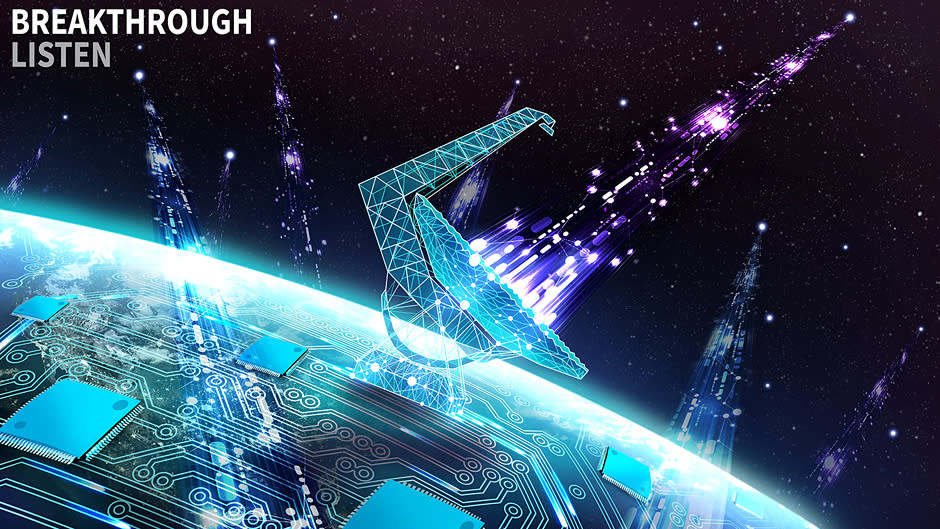Machine learning spots 8 potential technosignatures

Humans have five new leads in the search to find life beyond our solar system.
Scientists attempting to address the question, "Are we alone in the universe?" have used a new machine-learning technique to discover eight previously undetected "signals of interest" from around five nearby stars. The team applied an algorithm to previously studied data collected by the Green Bank Telescope in West Virginia as part of a campaign run by Breakthrough Listen, a privately funded initiative searching 1 million nearby stars, 100 nearby galaxies and the Milky Way's plane for signs of technologically advanced life.
And the project nearly didn't happen. "I only told my team after the paper's publication that this all started as a high-school project that wasn't really appreciated by my teachers," first author Peter Ma, now an undergraduate student at the University of Toronto in Canada, said in a statement.
Related: 10 things we learned about UFOs and aliens (or the lack thereof) in 2022
This isn't the first time that computer algorithms have been used to search the vastness of space for "technosignatures," technologically-generated signals that could mark other advanced extraterrestrial civilizations.
However, because many algorithms used to sift through telescope data were developed decades ago for early digital computers, they are often outdated and inefficient when applied to the massive datasets generated by modern observatories.
These classical algorithms had been used to examine the Green Bank Telescope data and this inefficiency could be why this data hadn't originally indicated any signals of interest in 2017, when scientists originally examined it. All told, the researchers analyzed 150 terabytes of data representing observations of 820 nearby stars, although they want to apply the algorithm to even more data.
"With our new technique, combined with the next generation of telescopes, we hope that machine learning can take us from searching hundreds of stars, to searching millions," Ma said in a statement.
The researchers found that the key strength of the new algorithm was to organize the data from telescopes into categories, allowing them to distinguish between real signals and "noise," or interference. Although telescopes involved in the search for technosignatures are placed in areas of the globe where there is minimal interference from human technology like cell phones, these signals still get picked up. (Most SETI programs focus on radio waves because they can travel at the speed of light across vast distances mostly unimpeded by obstacles like interstellar dust clouds; unfortunately, the very same characteristics have made radio waves the cornerstone of human communication on Earth.)
"In many of our observations, there is a lot of interference," Ma said. "We need to distinguish the exciting radio signals in space from the uninteresting radio signals from Earth."
To make sure the new algorithm wasn't confused by signals originating from Earth, Ma and the team trained their machine-learning tools to tell the difference between human-generated interference and potential extraterrestrial signals. They tested a range of algorithms, determining each algorithm's precision and how often it fell for false positives.
The most successful algorithm combined two subtypes of machine learning: supervised learning, in which humans train the algorithm to help it generalize, and unsupervised learning that can hunt through large data sets for new hidden patterns. United in what Ma called "semi-unsupervised learning," these approaches discovered eight signals that originated from five different stars located between 30 and 90 light-years away from Earth.
The signals are convincing candidates for genuine technosignatures, according to Steve Croft, project scientist for Breakthrough Listen. "First, they are present when we look at the star and absent when we look away — as opposed to local interference, which is generally always present," he said. "Second, the signals change in frequency over time in a way that makes them appear far from the telescope."
Croft cautioned that in massive datasets that can contain millions of signals, a single signal could have both of these characteristics by sheer chance alone. "It's a bit like walking across a gravel path and finding a stone stuck in the tread of your shoe that seems to fit perfectly," he said.
So although the researchers believe these eight signals resemble what a technosignature is expected to look like, they can't confidently say any or all of the signals originate from extraterrestrial intelligence. The scientists would have needed to detect the same signals multiple times, and this repetition didn't appear during brief follow-up observations by the Green Bank Telescope.
"I am impressed by how well this approach has performed on the search for extraterrestrial intelligence," Cherry Ng, a co-author on the research and an astronomer also at the University of Toronto, said in the same statement. "With the help of artificial intelligence, I'm optimistic that we'll be able to better quantify the likelihood of the presence of extraterrestrial signals from other civilizations."
Related stories:
— Alien hunters should look for city lights from 'urbanized planets,' study suggests
— SETI search of interstellar Comet Borisov finds no sign of alien 'technosignatures'
— Should we be looking for intelligence on a planetary scale?
The team now wants to apply the same algorithm to data gathered by observatories like the MeerKAT array in South Africa.
"We're scaling this search effort to 1 million stars today with the MeerKAT telescope and beyond," Ma said in a second statement. "We believe that work like this will help accelerate the rate we're able to make discoveries in our grand effort to answer the question, 'Are we alone in the universe?'"
The team's research was published Monday (Jan. 30) in the journal Nature Astronomy.
Follow us on Twitter @Spacedotcom or on Facebook.
